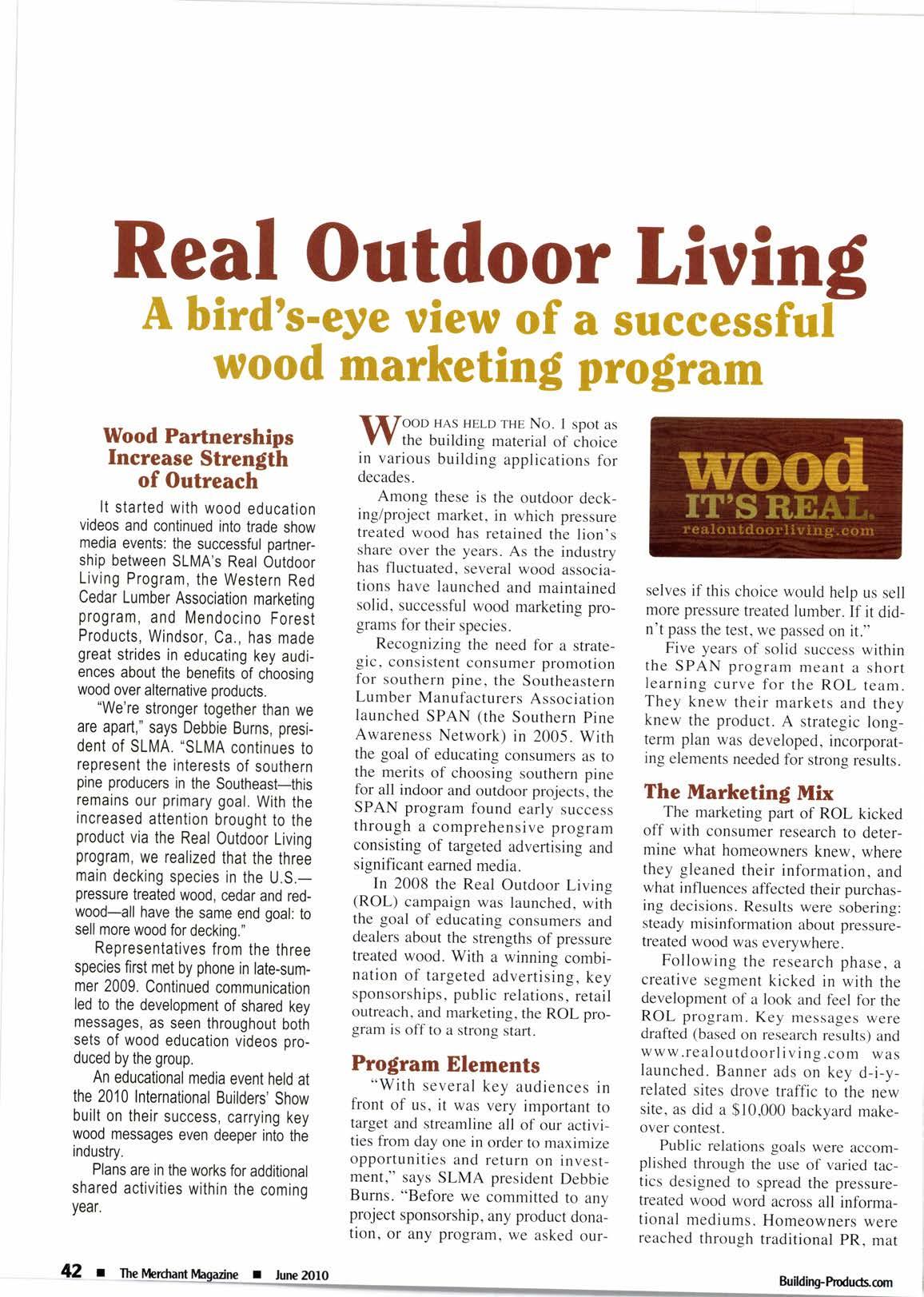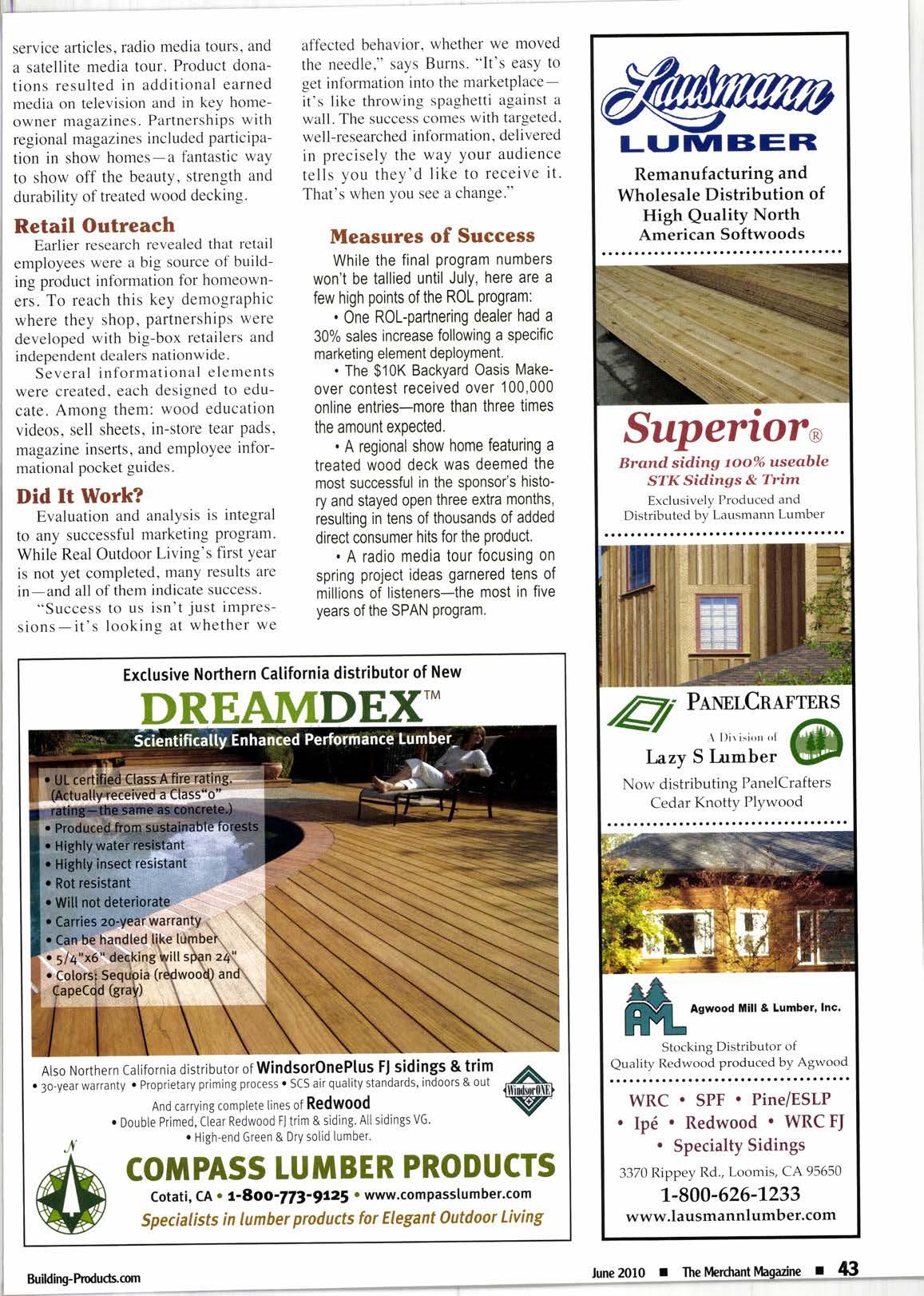
3 minute read
Real Outdoor Liuin€
A bird's-eye view of a successfuiwood marketing program
Wood Partnerships fncrease Strengfth of Outreach
It started with wood education videos and continued into trade show media events: the successful oartnership between SLMA's Real Outdoor Living Program, the Western Red Cedar Lumber Association marketing program, and Mendocino Forest Products, Windsor, Ca., has made great strides in educating key audiences about the benefits of choosing wood over alternative products.
"We're stronger together than we are apart," says Debbie Burns, president of SLMA. "SLMA continues to represent the interests of southern pine producers in the Southeast-this remains our primary goal. With the increased attention brought to the product via the Real Outdoor Living program, we realized that the three main decking species in the U.S.pressure treated wood, cedar and redwood-all have the same end goal: to sell more wood for decking."
Representatives from the three species first met by phone in late-summer 2009. Continued communication led to the development of shared key messages, as seen throughout both sets of wood education videos oroduced by the group.
An educational media event held at the 2010 International Builders' Show built on their success, carrying key wood messages even deeper into the industry.
Plans are in the works for additional shared activities within the comino year.
f f,/ooo HAS HELD rup No. I spot as V Y the building material of choice in various building applications for decades.
Among these is the outdoor decking/project market, in which pressure treated wood has retained the lion's share over the years. As the industry has fluctuated, several wood associations have launched and maintained solid, successful wood marketing programs for their species.
Recognizing the need for a strategic, consistent consumer promotion for southern pine, the Southeastern Lumber Manufacturers Association launched SPAN (the Southern pine Awareness Network) in 2005. With the goal of educating consumers as to the merits of choosing southern pine for all indoor and outdoor projects, the SPAN program found early success through a comprehensive program consisting of targeted advertising and significant earned media.
In 2008 the Real Outdoor Livins (ROL) campaign was launched, wit[ the goal of educating consumers and dealers about the strengths of pressure treated wood. With a winnins combination of targeted advertising. key sponsorships, public relations, retail outreach, and marketing, the ROL program is offto a strong start.
Program Elements
"With several key audiences in front of us, it was very important to target and streamline all of our activities from day one in order to maximize opportunities and return on investment," says SLMA president Debbie Burns. "Before we committed to any project sponsorship, any product donation, or any program, we asked our- selves if this choice would help us sell more pressure treated lumber. If it didn't pass the test, we passed on it."
Five years of solid success within the SPAN program meant a short learning curve for the ROL team. They knew their markets and thev knew the product. A strategic longterm plan was developed, incorporating elements needed for strong results.
The Marketing! Mix
The marketing part of ROL kicked off with consumer research to determine what homeowners knew, where they gleaned their information, and what influences affected their purchasing decisions. Results were sobering: steady misinformation about pressuretreated wood was everywhere.
Following the research phase, a creative segment kicked in with the development of a look and feel for the ROL program. Key messages were drafted (based on research results) and www.realoutdoorliving.com was Iaunched. Banner ads on kev d-i-vrelated sites drove traffic to ih" n"t site, as did a $10,000 backyard makeover contest.
Public relations goals were accomplished through the use of varied tactics designed to spread the pressuretreated wood word across all informational mediums. Homeowners were reached through traditional PR, mat service articles, radio media tours, and a satellite media tour. Product donations resulted in additional earned media on television and in key homeowner magazines. Partnerships with regional magazines included participation in show homes-a fantastic waY to show off the beautY, strength and durability of treated wood decking.

Retail Outreach
Earlier research revealed that retail employees were a big source of building product information for homeowners. To reach this key demograPhic where they shop, PartnershiPs were developed with big-box retailers and independent dealers nationwide.
Several informational elements were created, each designed to educate. Among them: wood education videos, sell sheets, in-store tear pads, magazine inserts, and employee informational pocket guides.
Did It Worlc?
Evaluation and analysis is integral to any successful marketing program. While Real Outdoor Living's first year is not yet completed, many results are in-and all of them indicate success.
affected behavior. whether we moved the needle," says Burns. "lt's easy to get information into the marketplaceit's like throwing spaghetti against a wall. The success comes with targeted, well-researched information, delivered in precisely the way Your audience tells you they'd like to receive it. That's when you see a change."
Measures of Success
While the final program numbers won't be tallied until July, here are a few high points of the ROL Program: One ROL-partnering dealer had a 30% sales increase following a specific marketing element dePloYment.
The $10K Backyard Oasis Makeover contest received over 100,000 online entries-more than three times the amount exoected.
A regional show home featuring a treated wood deck was deemed the most successful in the sponsor's history and stayed open three extra months, resulting in tens of thousands of added direct consumer hits for the product.
A radio media tour focusing on spring project ideas garnered tens of millions of listeners-the most in five years of the SPAN program.
By Dave Kahle










